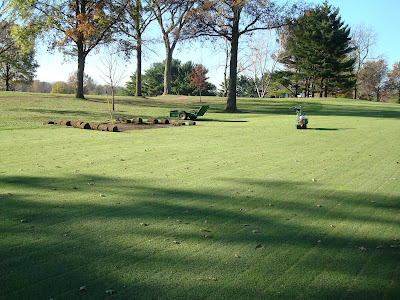This winter we will have turf covers on the putting green and on a portion of the driving range tee. Turf covers can be used to help prevent winter injury, and keep soil temperatures a little higher which allows for more rapid green-up in the spring. These are plastic covers that consist of holes to allow for water and air movement through the cover. Their greatest benefit for us comes when they create a greenhouse effect over the turf to trap heat and keep the soil temperatures higher. The increased soil temperatures will allow for more growth earlier in the spring.
We covered the putting green to continue to aid in the recovery of the areas that were sodded and overseeded earlier this year.
The covers were put on the driving range tee to help with the divot recovery. We do not anticipate these covers will allow us to open the tee sooner. However, when we do open the tee next spring, we hope to have more of the divots healed from this year.
We covered the putting green to continue to aid in the recovery of the areas that were sodded and overseeded earlier this year.
The covers were put on the driving range tee to help with the divot recovery. We do not anticipate these covers will allow us to open the tee sooner. However, when we do open the tee next spring, we hope to have more of the divots healed from this year.
































